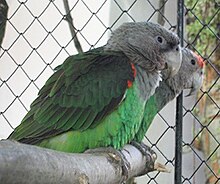| Brown-necked parrot | |
|---|---|

| |
| A grey-headed parrot (Poicephalus fuscicollis suahelicus) | |
| Conservation status | |
 Least Concern (IUCN 3.1) | |
| Scientific classification | |
| Domain: | Eukaryota |
| Kingdom: | Animalia |
| Phylum: | Chordata |
| Class: | Aves |
| Order: | Psittaciformes |
| Family: | Psittacidae |
| Genus: | Poicephalus |
| Species: | P. fuscicollis |
| Binomial name | |
| Poicephalus fuscicollis (Kuhl, 1820) | |
The brown-necked parrot (Poicephalus fuscicollis), sometimes known in aviculture as the uncape parrot, is a large Poicephalus parrot species endemic to Africa.
It consists of two subspecies: the savanna-dwelling brown-necked parrot (P. fuscicollis fuscicollis) and grey-headed parrot (P. f. suahelicus) subspecies. It formerly included the Cape parrot (now Poicephalus robustus) as a subspecies before the Cape parrot was re-classified as a distinct species.
Taxonomy
German naturalist Heinrich Kuhl described the brown-necked parrot in his 1819 work Conspectus Psittacorum. Although unsure of its country of origin, he felt it was definitely a distinct species and related to the Cape parrot. The species name is from the Latin words fuscus "dark" and collum "neck".
South Africa-based ornithologist Phillip Clancey proposed the Cape and brown-necked parrots were separate species in 1997 based on the shape and size of the bill, head coloration and preferred habitat. Mike Perrin observed that species status would facilitate protection of the endangered Cape parrot. Genetic analysis of the three taxa published in 2015 supported the distinctness of brown-necked and cape parrots, showing that ancestors of the two had diverged between 2.13 and 2.67 million years ago—in the late Pliocene to early Pleistocene epoch. This period was a period of changes in climate, where grassland and forest were expanding and contracting, which led to isolation and eventually speciation of separate populations.
The old name for the three taxa was Cape parrot, with virtually all the individuals in captivity belonging to what became P. fuscicollis. Jean Pattison called them Uncape parrots because of this.
Description
The largest member of its genus, the brown-necked parrot has a relatively large head and bill, and stocky build. It has a light grey head. The nominate subspecies fuscicollis has a bluer sheen to its plumage than suahelicus. The upperparts are yellow-green and underparts greenish.

Distribution
Subspecies fuscicollis is found in west Africa from Gambia and southern Senegal to Ghana and Togo. Locally common in places, it appears to have declined in Senegal and Gambia. Subspecies suahelicus is found in southern Africa from southern Congo and Tanzania to northern Namibia and south to northern South Africa.
Aviculture
The species adapts readily to captivity and is seen in the pet trade.
References
- BirdLife International (2017). "Poicephalus fuscicollis". IUCN Red List of Threatened Species. 2017: e.T22732670A119197072. doi:10.2305/IUCN.UK.2017-3.RLTS.T22732670A119197072.en. Retrieved 18 November 2021.
- Harris, Craig. "Uncape Parrot birds". BirdChannel. Archived from the original on 4 September 2014. Retrieved 28 August 2014.
- ^ Perrin, M.R. 2005. A review of the taxonomic status and biology of the Cape Parrot Poicephalus robustus, with reference to the Brown-headed Parrot P. fuscicollis fuscicollis and the Grey-headed Parrot P. f. suahelicus. Ostrich 76: 195–205
- Kuhl, Heinrich (1819). Conspectus Psittacorum : cum specierum definitionibus, novarum descriptionibus, synonymis et circa patriam singularum naturalem adversariis, adjecto indice museorum, ubi earum artificiosae exuviae servantur : cum tabulis III. aeneis pictis. Bonn, Germany: self-published. p. 93.
- Simpson, D.P. (1979) . Cassell's Latin Dictionary (5 ed.). London, United Kingdom: Cassell. pp. 116, 261. ISBN 0-304-52257-0.
- Coetzer WG, Downs CT, Perrin MR, Willows-Munro S (2015). "Molecular Systematics of the Cape Parrot (Poicephalus robustus): Implications for Taxonomy and Conservation". PLOS ONE. 10 (8): e0133376. Bibcode:2015PLoSO..1033376C. doi:10.1371/journal.pone.0133376. PMC 4534405. PMID 26267261.
- ^ Mattie Sue Athan; Dianalee Deter (2008). Guide to the Senegal Parrot and Its Family. Barron's Educational Series. pp. 15–16. ISBN 978-0-7641-3886-7.
- ^ Forshaw, Joseph M. (2010). Parrots of the World. Princeton University Press. p. 148. ISBN 9781400836208.
- ^ Barlow, Clive; Wacher, Tim; Disley, Tony (2005). A Field Guide to birds of The Gambia and Senegal. Yale University Press. p. 226. ISBN 9780300115741.
External links
 Media related to Poicephalus fuscicollis at Wikimedia Commons
Media related to Poicephalus fuscicollis at Wikimedia Commons
| Subfamily: Psittacinae | |
|---|---|
| Genus | |
| Psittacus | |
| Poicephalus | |
| Taxon identifiers | |
|---|---|
| Poicephalus fuscicollis | |